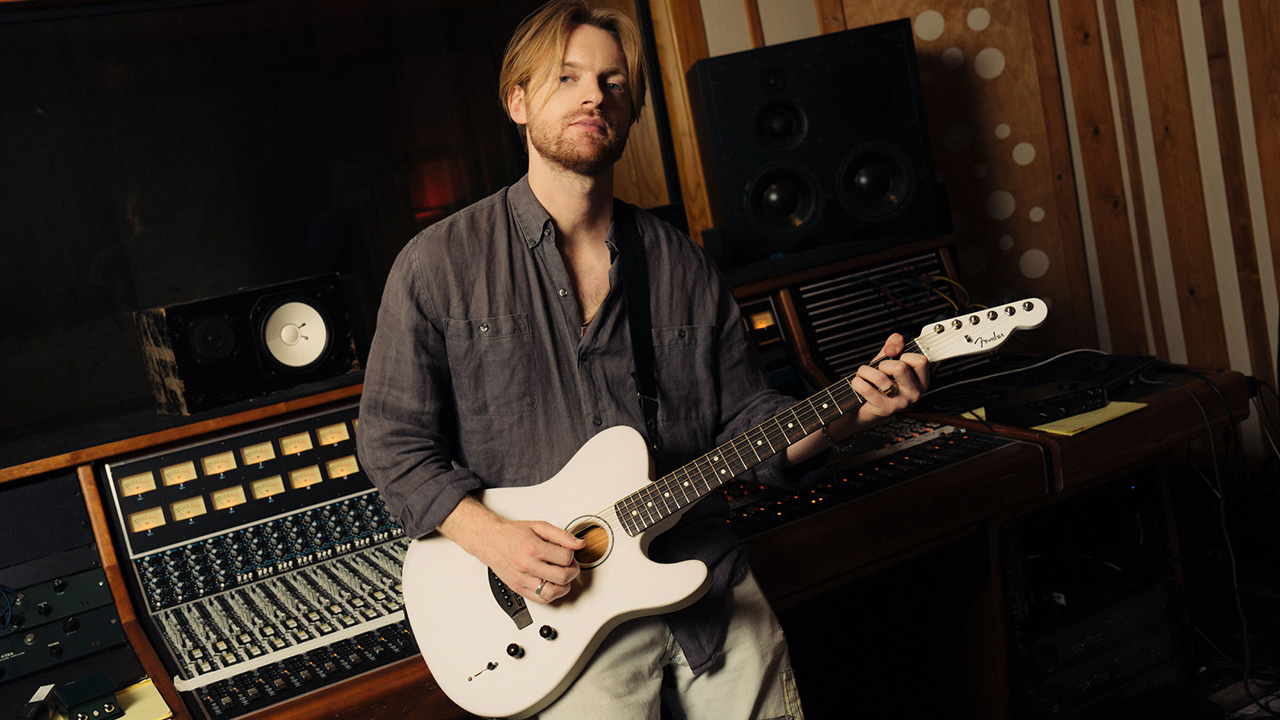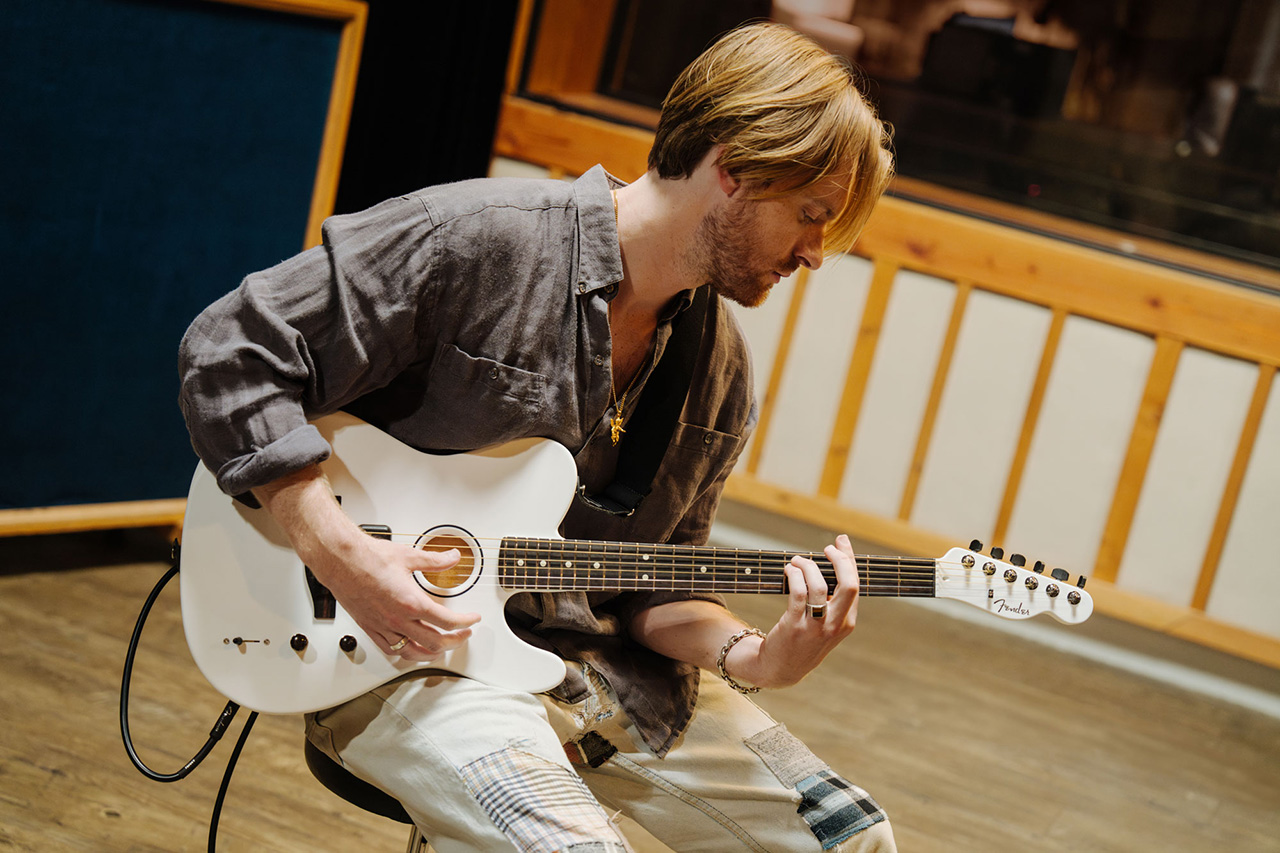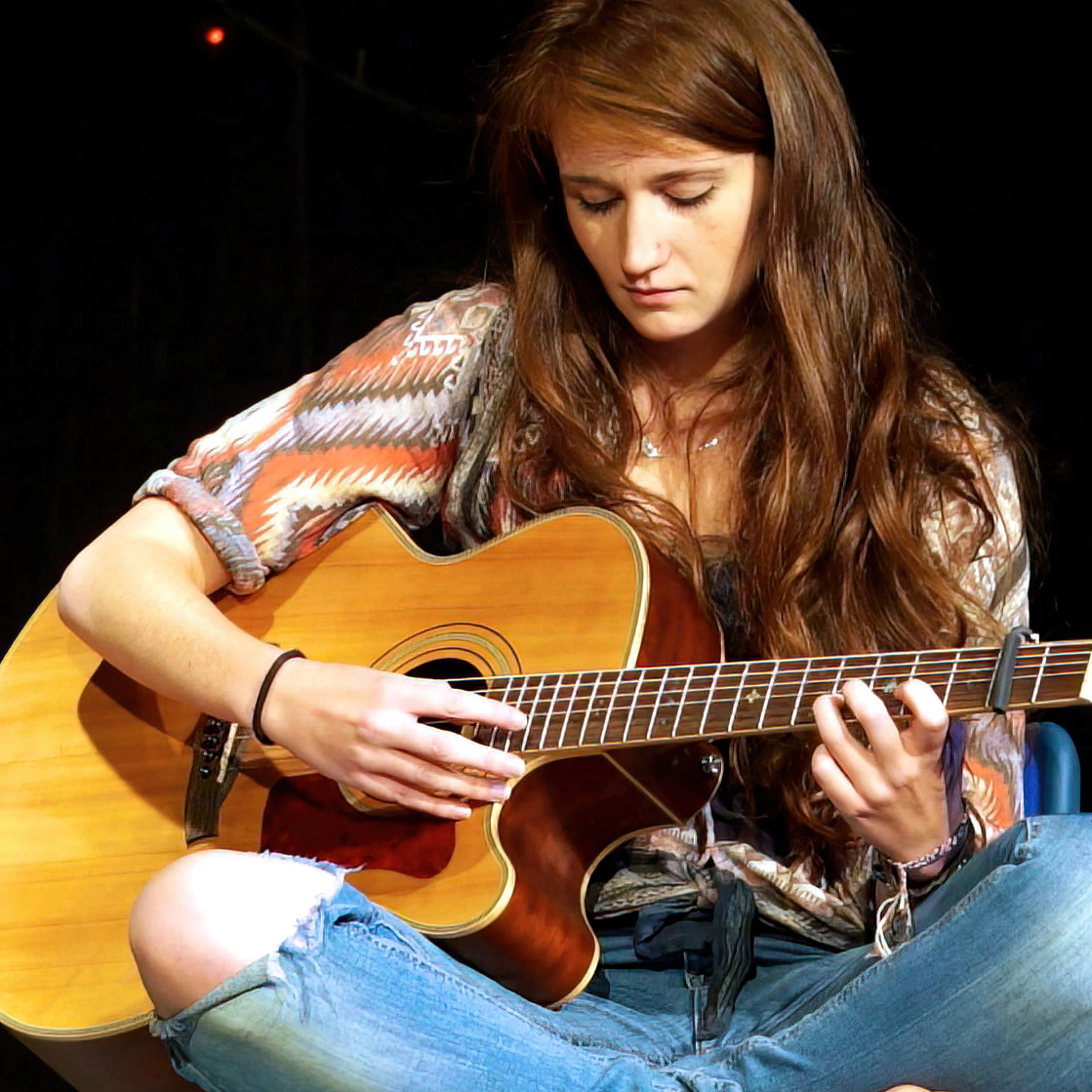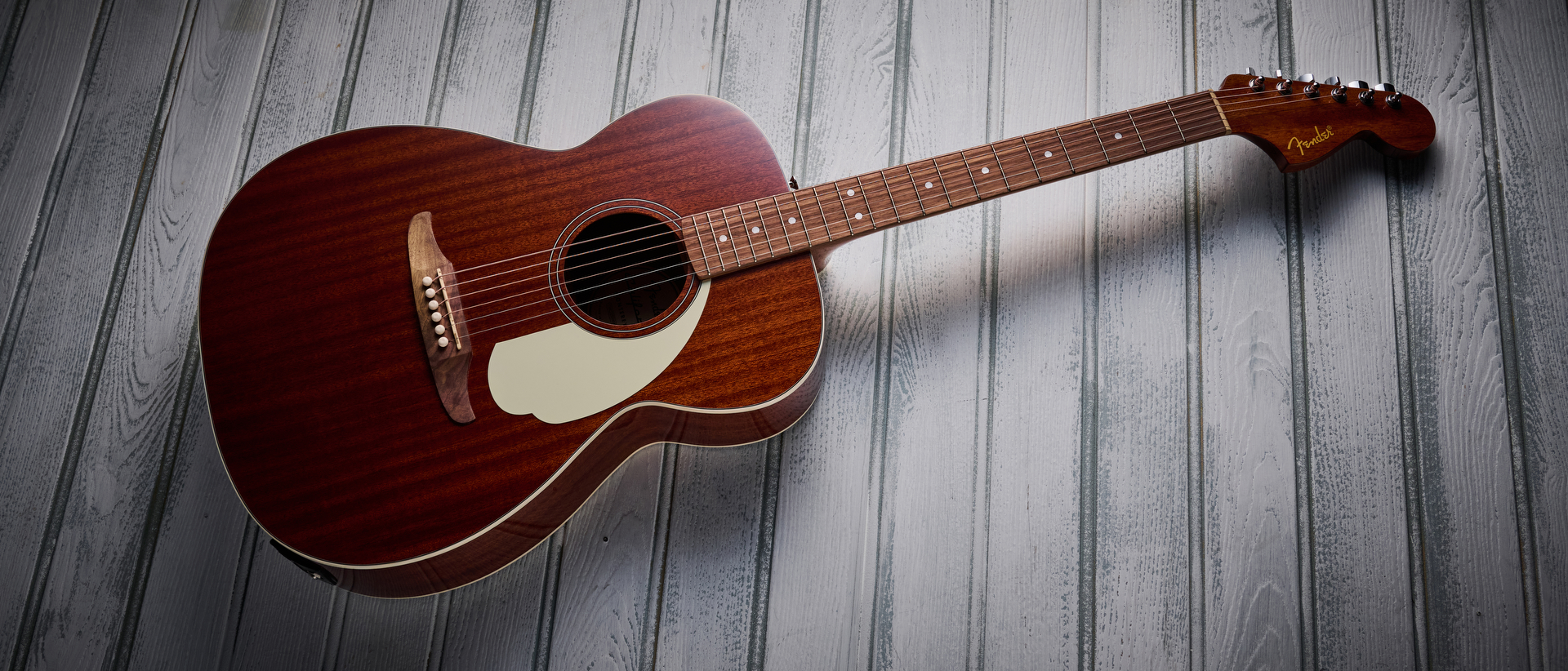“If you’re making music that’s got guitar on it, and not reaching the masses, you might be like, ‘Wow, people just hate guitar music.’ Well, I don’t think we can blame the guitar...” FINNEAS on bringing guitar back to pop and revamping the Acoustasonic
The producer and guitarist shares his recording insight, his new Fender signature model, plus the playing discussions he has with Billie Eilish

Ever since Fender debuted their American Acoustasonic Series Telecaster at NAMM in 2019, the innovative acoustic/electric hybrid has divided opinion. But that could be about to change after songwriter, guitarist and super-producer FINNEAS put his name – and some ingenious new twists – to the first two Acoustasonic Artist Signature models.
“I think it’s hard to get over your first impression of something,” he says from his Los Angeles studio, where he and his sister Billie Eilish cut their latest hit record, HIT ME HARD AND SOFT.
“If you were at NAMM, you picked up an instrument and played it in an environment where it was noisy as hell, and the model you played was one of their first, you’re entitled to have had your bad experience. But I think it’s also important to understand how far something has come.”
The FINNEAS signature range includes an Ensenada-built Cappuccino Fade Acoustasonic Player Telecaster and a Limited Edition Acoustasonic Telecaster, which is crafted in the USA and comes in Arctic White.
He says: “These models have capabilities that the one you played five years ago just didn’t have. I think of it as a guitar first, but also as a piece of technology – and the technology has gotten way better.”
His history with Acoustasonics goes way back, having played custom colorway models throughout his 2019 tour with Eilish and proudly sported one on SNL the same year. He even dedicated time to discussing them via Fender’s Acoustasonic hotline service in 2021. “I felt I was experiencing the unique benefits of that guitar,” he says. “It’s like it was tailor-made for me as a player.”
FINNEAS first gravitated towards the slim-bodied hybrids “to solve the specific problem of on-stage feedback” but he was quickly struck by their versatility. When invited to put his own stamp on the design, the next step was to come up with new built-in tonal capabilities.
All the latest guitar news, interviews, lessons, reviews, deals and more, direct to your inbox!
“I thought we could take it a step further if we could on-board some effects,” he explains. “It’s a digital instrument, so to speak. It’s an electric emulation, so we can emulate other stuff. We threw a chorus on the acoustic, and a chorus/phase on the electric. They sound sick!”

The Player model features a three-way switch and six custom-modeled acoustic and electric voices, while the Limited Edition has a five-way switch and 10 custom voices. The raison d'être of both is to increase tonal control right at your fingertips, reducing the need for excessive gear.
“It’s the difference between bringing four guitars – or an electric guitar, an acoustic guitar and pedals – to a gig, versus one guitar. That’s really exciting to me. Sometimes versatility is at the cost of quality, but I think this stuff all sounds pretty good.”
I always try to get Billie to play guitar as much as she’s willing to… she feels less experienced but I like her sensibilities
You hear FINNEAS’ Acoustasonics on much of his recent musical output, including HIT ME HARD AND SOFT, which features guitars more prominently than any other Eilish record to date.
“It’s much closer to an electric guitar’s action than an acoustic action,” he explains. “Billie has spent less time than me playing guitar. I often teach her how to play our songs on the Acoustasonic because it’s easier for her to get the chord shapes down and practice on it.

“I always try to get her to play as much as she’s willing to on our records because, even though she feels like she’s less experienced, I really like her sensibilities.”
Asked if she specifies the kind of guitar playing she wants from him on her tracks, he replied: “Her number one piece of feedback is to be quieter! She’s a big fan of me thumbing stuff. Oftentimes, it’s not even between an actual pick or me strumming – she’s like, ‘I want the thumb!’ She wants that super, super tender thing.
“Then, sometimes, we bicker and maybe I win… With WILDFLOWER specifically, I was strumming a certain way and she wanted it way quieter. I said, ‘I think this strumming is really effective for this song – it has a lot of rhythm in it. We’ll turn it down and it’ll be great!”
FINNEAS’ solo work tends to be more guitar-based than his sister’s. The lead single and title track of his forthcoming LP For Cryin’ Out Loud! places clean electric tones and crisp rhythms amid a poppy arrangement of horns, driving drums and layers of topline vocals.
As a producer and songwriter, he’s played a key role in inserting guitars into some of the biggest pop records of recent years, such as Romance by Camila Cabello.

“I don’t take any ownership over bringing guitar back,” he says. “I think it’s more that whatever is being used in a big, accessible, contemporary song is what’s in vogue.”
He points to Sabrina Carpenter’s funky electric guitar-propelled hit Espresso and singles out Mk.gee as an artist who’s putting the instrument front and center. He offers observation that’s worth remembering next time you find yourself in a debate about the so-called death of guitar.
I’m a big fan of putting a mic on the fretboard. If it’s an electric guitar, hearing the ‘chunk’ is really fun
“If you’re making music that’s got guitar on it, and it doesn’t feel like it’s reaching the masses, you might be like, ‘Wow, people just hate guitar music, huh?’ Well, I don’t think we can blame the guitar – I think we’ve got to blame the band!”
FINNEAS’ success at integrating guitars into pop contexts also stems from his production ear for detail and nuance. He says his approach to recording as “all about pairing” and he’ll often create multiple layers for any given guitar part.

His go-to amps include a Vox AC30 and some small vintage Fender combos, and he used a Kemper to record HIT ME HARD AND SOFT. Unsurprisingly, he also utilizes a number of plugins and amp simulators, including Native Instruments Guitar Rig 7 Pro and Two Notes GENOME – the latter of which played a particularly important role in the making of his new album.
“I’d run the AC30, but I’d also run the guitars on a DI split and then blend them,” he explains. “If I’m running an amp, I’m also a big fan of just putting a mic on the fretboard. If it’s an electric guitar, hearing the ‘chunk’ is really fun.
“It’s often about trying to get the thing to sound as close to how it sounds in the room that I’m in. What I’m hearing might be the amp I’m playing through over in the corner, and I’m trying to mix it that way. I’m putting the amp over to one side and I’m putting the mic from the actual fretboard dead center.”
But his number-one trick is simple: “This is going to sound mean, but it’s really about how you play the guitar. I can record a shitty guitar with a cheap microphone or a DI. If I just spend a little extra time on the feel of how I’m shaping it and what kind of rhythm I’m hitting, that’s what really matters. The mic and the tech side of it is so secondary to your playing.”
- For more info on the FINNEAS Acoustasonic Telecaster models, head to Fender.com.
Since graduating university with a degree in English, Ellie has spent the last decade working in a variety of media, marketing and live events roles. As well as being a regular contributor to GuitarWorld.com, she currently heads up the marketing team of a mid-scale venue in the south-west of England. She started dabbling with guitars around the age of seven and has been borderline obsessed ever since. She has a particular fascination with alternate tunings, is forever hunting for the perfect slide for the smaller-handed guitarist, and derives a sadistic pleasure from bothering her drummer mates with a preference for wonky time signatures.

